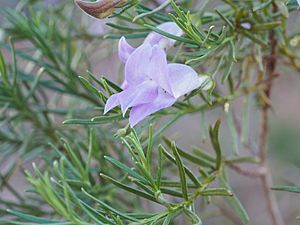Sticky emu bush facts for kids
Quick facts for kids Sticky emu bush |
|
|---|---|
 |
|
| Eremophila glutinosa leaves and flowers | |
| Scientific classification | |
| Genus: |
Eremophila (plant)
|
| Species: |
glutinosa
|
The Eremophila glutinosa, often called the sticky emu bush, is a beautiful flowering plant. It is part of the figwort family and grows only in Western Australia. This plant is a shrub that stands upright and has many leaves. Its branches and leaves feel sticky and look shiny because they have a natural sticky substance called resin. The sticky emu bush also has fuzzy green parts called sepals and pretty lilac-colored flowers.
Contents
What the Sticky Emu Bush Looks Like
The sticky emu bush is an upright shrub that can grow from about 0.4 to 3 meters (1.3 to 9.8 feet) tall. Its branches are covered with tiny, sticky hairs. These hairs are often hidden by a thick layer of resin, which makes the plant sticky.
The leaves are usually 8 to 20 millimeters (0.3 to 0.8 inches) long and 0.5 to 1.5 millimeters (0.02 to 0.06 inches) wide. They grow close together near the ends of the branches. The leaves are long and thin, with a groove on their underside, and they are also covered in resin.
Flowers and Fruits
The flowers of the sticky emu bush grow one by one where the leaves meet the stem. Each flower sits on a sticky, hairy stalk that is usually 1.5 to 6.5 millimeters (0.06 to 0.26 inches) long.
Each flower has 5 green, overlapping parts called sepals. These sepals are shaped like a spear or an egg and are usually 6 to 10.5 millimeters (0.24 to 0.41 inches) long. They are hairy both inside and out.
The petals of the flower are 10 to 25 millimeters (0.4 to 1.0 inches) long. They are joined at the bottom to form a tube shape. The tube is a lovely shade of lilac. Inside the tube and on some of its outer parts, you can see dark spots. The outside of the tube has a few hairs, but the inside of the petal parts is smooth. The inside of the tube is very fuzzy.
There are 4 stamens, which are the parts that hold pollen. These stamens are completely hidden inside the flower's tube. The sticky emu bush blooms from June to October. After the flowers, it produces dry, woody, and hairy fruits that are 4 to 6 millimeters (0.16 to 0.24 inches) long.
How it Got its Name
The sticky emu bush was first officially described by a scientist named Robert Chinnock in 1979. He published his description in a scientific journal.
The second part of its scientific name, glutinosa, comes from a Latin word. This Latin word means "sticky" or "viscous." This name was chosen because the leaves of this plant are very sticky.
Where the Sticky Emu Bush Grows
The sticky emu bush usually grows on rocky hills. You can also find it on large granite rocks or along temporary streams. It prefers to grow in clay or sandy soils.
It is found in Western Australia, in the areas between Laverton and Mount Augustus. These areas include the Avon Wheatbelt, Gascoyne, Murchison, and Yalgoo regions.
Conservation Status
The Western Australian Government's Department of Parks and Wildlife has looked at the sticky emu bush. They have classified it as "not threatened." This means that there are enough of these plants in the wild, and they are not currently in danger of disappearing.
Growing the Sticky Emu Bush
The sticky emu bush is not very well known among people who grow plants. It has mostly been grown by taking a part of the plant and attaching it to the root system of another plant called Myoporum. This method is called "propagating onto rootstock."
This plant can grow well in full sunlight or in partial shade. However, it needs to be protected from frost, which can harm it.
Images for kids
-
E. glutinosa growing near Mount Augustus


